Create successful ePaper yourself
Turn your PDF publications into a flip-book with our unique Google optimized e-Paper software.
A <strong>Short</strong> <strong>History</strong> <strong>About</strong> <strong>PLC</strong> <strong>and</strong> <strong>DCS</strong><br />
Alfred Theorin<br />
Vanessa Romero Segovia
◮ <strong>PLC</strong><br />
Outline<br />
◮ Motivation<br />
◮ Problems faced during the 60’s<br />
◮ The Birth of the <strong>PLC</strong> (1968)<br />
◮ The Race is On<br />
◮ The <strong>History</strong> goes On<br />
◮ Fathers of the <strong>PLC</strong><br />
◮ <strong>PLC</strong> Evolution
Motivation<br />
Figure: Drinking Water Plant La Tomilla, Arequipa - Peru
Problems faced during the 60’s<br />
◮ Control systems implemented using relay controller<br />
◮ Lack of flexibility for process changes or expansion<br />
◮ Troubleshooting: ”Five hours to find it <strong>and</strong> five minutes to<br />
fix it”
The Birth of the <strong>PLC</strong> (1968)<br />
Bill Stone part of the Hydramatic Division of GM presents a<br />
paper at the Westinghouse Conference.<br />
The paper outlined problems related with reliability <strong>and</strong><br />
documentation for the machines at this plant. It also presented<br />
a design criteria to developed a ”st<strong>and</strong>ard machine controller”<br />
which included:<br />
◮ Elimination of costly scrapping of assembly-line relays<br />
during model changeovers <strong>and</strong> replace unreliable<br />
electromechanical relays<br />
◮ Reduction of machine downtime related to controls<br />
problems<br />
◮ Provide for future expansion, it had to be modular<br />
◮ Work in an industrial environment
The Race is On<br />
These specifications along with a proposal request to build a<br />
prototype, were given to four control builders:<br />
◮ Allen-Bradley, by way of Michigan-based Information<br />
Instruments, Inc.<br />
◮ Digital Equipment Corporation (DEC)<br />
◮ Century Detroit<br />
◮ Bedford Associates
The Race is On<br />
◮ Digital Equipment brings a ”mini-computer”, rejected due to<br />
static memory<br />
◮ Allen-Bradley has two attempts: PDQ II <strong>and</strong> PMC. Both of<br />
them too large, too difficult to program <strong>and</strong> too complex<br />
◮ Bedford Associates (Morley, Greenberg, L<strong>and</strong>au, Schwenk<br />
<strong>and</strong> Boissevain) already working from 1968 on the ”084”.<br />
They form Modicon <strong>and</strong> together in 1969 build the<br />
”Programmable Controller 084” also known as the<br />
”Modicon 084” which wins the proposal
The <strong>History</strong> goes On<br />
◮ In 1971, Allen-Bradley (Struger <strong>and</strong> Dummermuth) present<br />
the ”Bulletin 1774 <strong>PLC</strong>” also known as the ”<strong>PLC</strong>”<br />
◮ In 1973, Modicon (Greenberg <strong>and</strong> Rousseau) develop the<br />
”Modicon 184”, which produces the take off of Modicon
The <strong>History</strong> goes On<br />
◮ The acceptance of the <strong>PLC</strong> during its early days was very<br />
difficult<br />
◮ ”It was difficult to convince that a small box could replace<br />
50 feet of cabinets” (Morley)<br />
◮ ”Considerable effort was made to not identify <strong>PLC</strong>s as<br />
computers due to the poor reliability of computers <strong>and</strong> the<br />
fact that they were not things procured by manufacturing<br />
operations” (Morley)<br />
◮ Another difficult rising was because of the dedicated<br />
hardware terminals employed to program the early <strong>PLC</strong><br />
versions
The <strong>History</strong> goes On<br />
◮ Scott Zifferer (ICOM Software), focused on Allen-Bradley<br />
products. ”I wanted to use a computer for <strong>PLC</strong><br />
programming <strong>and</strong> documentation, instead of the dedicated<br />
hardware A-B called a T-3 Terminal”. The evolutionary<br />
approach enhanced the user interface, helped control<br />
engineers <strong>and</strong> maintenance people interface with A-B<br />
<strong>PLC</strong>s<br />
◮ Neil Taylor (Taylor Industrial Software), focused on<br />
Modicon products. ”I was consulting <strong>and</strong> saw the need to<br />
replace drafting table-produced ladder diagrams, which<br />
cost plenty to maintain <strong>and</strong> too much time to create.” His<br />
interest on documentation resulted on a variety of report<br />
options <strong>and</strong> reporting formats which helped<br />
troubleshooting the <strong>PLC</strong>s (offline)
Richard Morley<br />
◮ Bedford Associates,<br />
Modicon<br />
◮ More than 20 US<br />
patents<br />
◮ Novel computer design,<br />
AI, chaos <strong>and</strong><br />
complexity, factory of<br />
the future<br />
Fathers of the <strong>PLC</strong><br />
Odo Josef Struger<br />
◮ Allen-Bradley<br />
◮ <strong>PLC</strong> acronym, holds 50<br />
patents<br />
◮ Leadership role<br />
developing NEMA, IEC<br />
1131-3
<strong>PLC</strong> Evolution<br />
◮ In the early 1980s <strong>PLC</strong>s begun<br />
incorporating distributed control<br />
functions<br />
◮ During the 90s, st<strong>and</strong>ardization <strong>and</strong><br />
open systems were the main themes<br />
◮ Ethernet peer-to-peer networking<br />
became available from virtually all<br />
<strong>PLC</strong> manufacturers<br />
◮ Redundancy became a st<strong>and</strong>ard<br />
product<br />
◮ Appearance of very small nano or<br />
pico <strong>PLC</strong>s<br />
◮ Safety <strong>PLC</strong>s featuring triple<br />
redundancy were introduced
◮ <strong>DCS</strong><br />
Outline<br />
◮
1950s - The Pioneering Period<br />
Figure: Harvard Mark I 1944<br />
◮ Thomson Ramo Wolridge<br />
◮ Online after 3 years<br />
◮ MTBF 50 – 100h<br />
◮ Addition 1ms, Multiplication<br />
20ms<br />
◮ Supervision, printing<br />
instructions, set point<br />
control<br />
◮ Control still analog
1950s - The Pioneering Period<br />
◮ Improved underst<strong>and</strong>ing<br />
◮ Specialized hardware<br />
◮ interrupts<br />
Figure: IBM1710 from 1961
1960s - Direct Digital Control<br />
◮ Imperial Chemical<br />
Industries<br />
◮ Direct Digital Control<br />
◮ Bloodhound Mk2 Missile<br />
◮ Only large systems<br />
◮ Digital operator panels<br />
◮ Better flexibility
1960s - Direct Digital Control<br />
◮ DDC languages<br />
◮ No programming, just configuration<br />
◮ Only pre-defined control<br />
◮ Building automation<br />
◮ Function Blocks
1970s - Cheaper Computers<br />
Figure: IBM1800 from 1964<br />
◮ Minicomputers<br />
◮ Cheaper, faster, more<br />
reliable<br />
◮ Smaller systems<br />
◮ Faster processes<br />
◮ More critical processes<br />
◮ 1970 5,000→1975 50,000<br />
◮ Boot time!
1970s - Cheaper Computers<br />
◮ Microcomputers – Cheaper, faster, more reliable<br />
◮ $10,000→$500<br />
◮ Final blow
1980s - <strong>DCS</strong> Emerges<br />
◮ Until now - Analog to digital<br />
◮ R-Tec - Advanced building<br />
system<br />
◮ Midac - Distributed DDC<br />
◮ 11 microprocessors<br />
sharing tasks <strong>and</strong> memory<br />
◮ Coordinated distributed<br />
controllers over a serial<br />
network
◮ New control languages<br />
◮ Token Bus Network<br />
1980s - <strong>DCS</strong> Emerges<br />
◮ Redundancy <strong>and</strong> real-time communication
1990s - The Fieldbus Wars<br />
◮ Communication analog to<br />
digital<br />
◮ No st<strong>and</strong>ard<br />
communication protocol<br />
◮ Fieldbuses<br />
◮ Many organizations <strong>and</strong><br />
<strong>DCS</strong> vendors<br />
◮ Many fieldbuses<br />
◮ Yes indeed many!
1990s - The Fieldbus Wars<br />
◮ Microsoft Windows<br />
◮ OPC
◮ COTS<br />
1990s - The Fieldbus Wars<br />
◮ Hardware→Software
Outlook<br />
◮ <strong>PLC</strong> <strong>and</strong> <strong>DCS</strong> more similar














